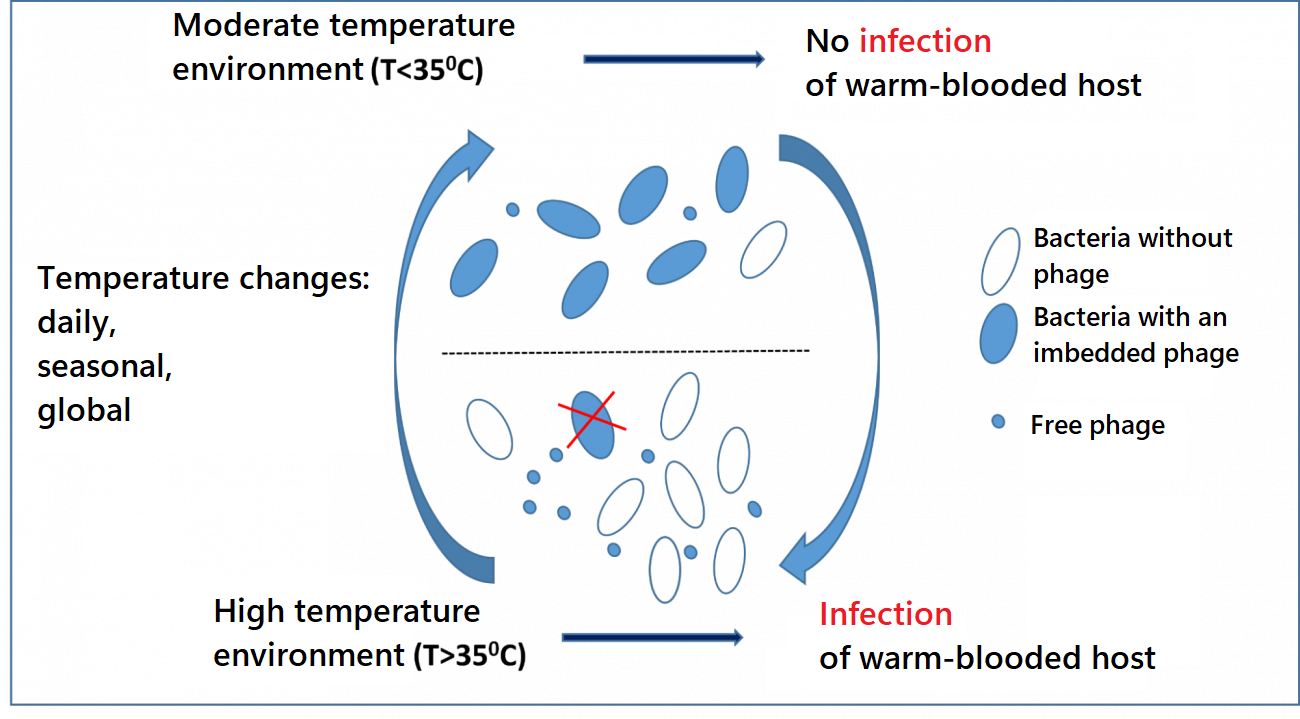
Ongoing climate change and human activities are transforming the dynamics of pathogenic bacterial populations in the natural environment, increasing the risk of infectious diseases. Among the key mechanisms of bacterial population amplification is the disruption of their natural regulation by phages (bacterial viruses). Some phages that control pathogenic bacteria are characterized by temperature-dependent lysogeny. In this case, the type of phage infection of a bacterium (lytic or lysogenic) is determined by the temperature of the environment. In particular, at high temperatures, phages infect bacterial cells and undergo a lytic cycle, which leads to lysis of the infected cells and the release of free phages. However, at lower temperatures, phages mainly lysogenize their host: the phage remains inside the bacterial cell, without causing its lysis. Temperature-dependent lysogeny is schematically shown in the figure.
The best known example of temperature-dependent lysogeny is the system involving the highly pathogenic bacterium Burkholderia pseudomallei and the phage AMP1. B. pseudomallei causes melioidosis, an extremely dangerous disease in Southeast Asia and other tropical/subtropical regions of the planet (about 90,000 deaths per year). Human infection occurs by acquiring phage-free bacteria from the environment, whereas ingestion of a lysogenized pathogen into a warm-blooded host would pose a much lower risk. Indeed, in a warm environment inside the host (with temperatures > 350C), phage-lysogenized bacteria will switch to the lytic cycle of infection with final lysis of the pathogen, thus causing no harm to the host (human). Until recently, the regulation of B. pseudomallei density by phages in the environment and the role of phages in pathogen infectivity have been largely ignored in the scientific literature. However, available empirical data suggest that phages have the potential to control B. pseudomallei density in water or soil. The switch between infection cycle types in this system occurs at 350C, so in geographic areas where temperatures fluctuate around this critical value, further warming due to global climate change may result in the dominance of non-phage pathogens, leading to an expansion of melioidosis endemic areas.
Using mathematical modeling, a team of scientists, including A.Yu. Morozov, a senior researcher at the A.N. Severtsov Institute of Ecology and Evolution of the Russian Academy of Sciences (IEE RAS), studied how climate change and the use of standard agricultural methods affect the interaction of bacteria with a phage characterized by temperature-dependent lysogeny.
“With the help of mathematical modeling, a prognosis was made for the dynamics of the phage-pathogen system in Thailand for the period 2024-2044 (melioidosis is particularly rampant in this country). Both spatially homogeneous and spatially heterogeneous mathematical models were considered to simulate the dynamics of the B. pseudomallei population in the surface waters of rice fields and in the soil of Thailand,” said A.Yu. Morozov.
Computer calculations based on the model predict a sharp increase in the pathogen density due to less effective control by the phage caused by global warming. The modeling also predicts that some modern agricultural practices (e.g. heavy use of herbicides) may increase the risk of acquiring melioidosis by changing the density of the pathogen in the environment.
The results are published in Scientific Reports. Morozov, A., Ageel, A., Bates, A. and Galyov, E., 2025. Modeling the effects of climate change on the interaction between bacteria and phages with a temperature-dependent lifecycle switch. // Scientific Reports, 15(1), p.6428.
